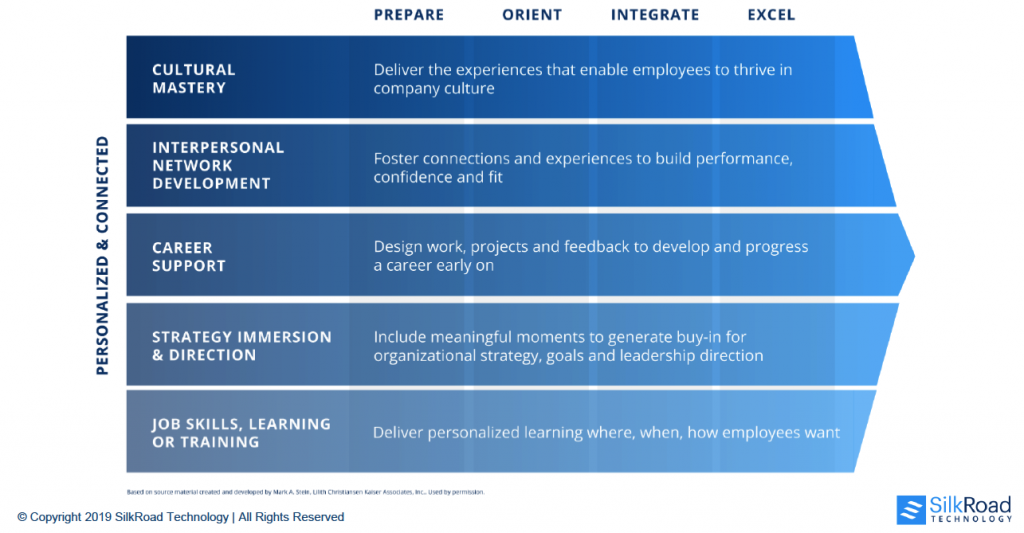Recently Dynamic Business attended Gartner’s ReImagine HR event in Sydney, where Silk Road Technology presented insights on the importance of successful onboarding for attracting and retaining talent. The research included in the talk also demonstrated the cost implications for a business or organisation that doesn’t have a good onboarding process in place.
Silk Road Technology collated some important stats from the field so far this year:
- 20% of employee turnover happens in the first 90 days (IDC research)
- Only 12% of employees believe their organisation does a great job at on boarding (Gallup)
- The total cost of replacing an employee is estimated at 1.5-2x annual salary (Deloitte)
According to insights from Forbes, two out of three CFOs say that their firm has a hard time keeping their best employees; in fact, more than half of all companies in the research (57%) lose 10% or more of their new hires within just their first year. These unwanted turnovers are expensive to businesses, and 9 out of 10 CFOs interviewed believe that proper onboarding could decrease the costs associated with unwanted turnovers.
Silk Road Technology has put together the three essential components of strategic onboarding.
1. Engagement
You must connect new hires to their mentors and make sure they know who to approach in the office for certain questions and issues. Who are they likely to interact with in their job? Introduce them to those key people with specific interest meaningfully. Driving engagement and acculturation starts from day one. In the talk, Lilith Christiansen, Vice President of Onboarding Solutions at Silk Road Technology, spoke about the example of using a buddy system, where an existing employee (relevant to the new hire’s job role) is responsible for helping them navigate through their first few days. From making those initial introductions – to pointing them to the kitchen and coffee-making facilities.
2. Workflow
With regards to the new hire’s workflow, you want to give them highly personalised content to make sure they understand their new roles and responsibilities undoubtedly. Those things that may now seem simple to you as a long-standing employee at your work place and within your workflow are the non-obvious things to a newcomer. All procedures need to be explained correctly, and walked through, all at a manageable pace.
3. Forms management
A really important factor is having tech in place to drive efficiency and accuracy in the onboarding process. How frustrating and also unprofessional can it look when you have one thousand messy forms to sign on your new desk? Make this experience seamless for new hires and show them how forward-thinking, innovative and efficient your organisation is with eForms that have pre-populated data and electronic signatures.

Successful onboarding is supporting talent along the whole employee journey, and it starts at the recruitment stage.
What impression are you giving to your potential new hire from the role advertisement itself, the communication to invite them in for an interview and the initial environment they see when they come to meet you? All of these early stages are vital for a good onboarding process and reducing those aforementioned costs.
From there, we move to the actual hiring (offering the job) and the pre-boarding, the latter of which is usually not given enough attention at all.
Pre-boarding is about getting everything ready before the new hire arrives on their first day, and it includes things like uniforms, passwords, seating – getting all of those small but important things ready so that on day one, the more important components (the three mentioned above) can be given priority.
If you have any organisation videos or documents that you can share with the new hire, this would be a great time and opportunity to do so. It shows your excitement to have them on the team, as well your well-organised and prepared attitude, which let’s face it, is absolutely miles better than a short misspelled email with just a start date on it. It’s a chance to show them how great you are, what the culture is like and reaffirms their decision to chose you as their next employer.
Once the new hire is in, however, the onboarding doesn’t actually stop there. There should be constant efforts made to retain your talent and you should be considering all of these stops on the line of recruitment:
As already discussed:
- Recruiting
- Hiring
- Preboarding
- New hire
Then, continuing:
- Promotions
- Transfers
- Projects
- Acquisitions
- Leave
- Exits
- Alumni
Details of all of these stages are summarised in the Silk Road Technology infographic below and it shows a great example of what the onboarding journey should look like.



